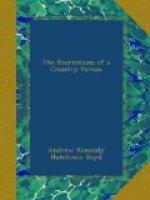The railway carriages that run between Glasgow and Greenock have a rather peculiar appearance. The first-class carriages are of twice the usual length, having six compartments instead of three. Each compartment holds eight passengers; and as this accommodation is gained by increasing the breadth of the carriages, brass bars are placed across the windows, to prevent any one from putting out his head. Should any one do so, his head would run some risk of coming in collision with the other train; and although, from physiological reasons, tome heads might receive no injury in such a case, the carriage with which they came in contact would probably suffer. The expense of painting is saved by the carriages being built of teak, which when varnished has a cheerful light-oak colour. There is a great crowd of men on the platform, for the four o’clock train is the chief down-train of the day. The bustle of the business-day is over; there is a general air of relief and enjoyment. We meet our friend punctual to the minute; we take our seat on the comfortable blue cushions; the bell rings; the engine pants and tugs; and we are off ‘down the water.’
We pass through a level country on leaving Glasgow: there are the rich fields which tell of Scotch agricultural industry. It is a bright August afternoon: the fields are growing yellow; the trees and hedges still wear their summer green. In a quarter of an hour the sky suddenly becomes overcast. It is not a cloud: don’t be afraid of an unfavourable change of weather; we have merely plunged into the usual atmosphere of dirty and ugly Paisley. Without a pause, we sweep by, and here turn off to the right. That line of railway from which we have turned aside runs on to Dumfries and Carlisle; a branch of it keeps along the Ayrshire coast to Ardrossan and Ayr. In a little while we are skimming the surface of a bleak, black moor; it is a dead level, and not in the least interesting: but, after a plunge into




